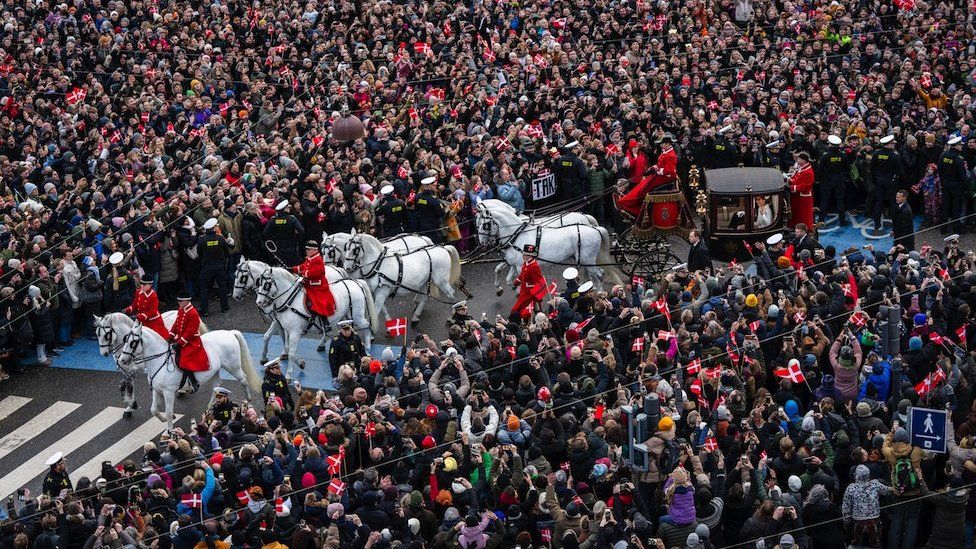ARTICLE AD BOX
 Image source, Getty Images
Image source, Getty Images
A crowd of 100,000 lined the streets of Copenhagen to celebrate the new king
By Daniela Relph
Royal correspondent, in Copenhagen
In the UK, there hadn't been a new monarch for 70 years. In Denmark, it had been 52 years. But I've now been to two 'coronations' in the space of eight months.
I was at Westminster Abbey for the coronation of King Charles III last May, and at Christansborg Palace, in Copenhagen, for the proclamation of King Frederik X, on Sunday.
In the UK, the centre of the Coronation was a deeply religious ceremony, steeped in ancient tradition, with the anointing of the monarch with holy oil and a crown being placed upon his head.
In Denmark, it was inside a government meeting, the signing of an abdication declaration and a prime minister proclaiming a new king from a palace balcony.
The choreography was different. The ritual was less complicated and extravagant in Denmark. But what was surprising was the two events felt strangely similar.
I joined more than 100,000 people on the streets of Copenhagen over the weekend to witness the first change of sovereign here since 1972. Everyone had told me it would be quite low key.
"Nothing like what you Brits do for a new monarch," one person said.
I was ready for an event that reeked of Scandinavian coolness, a casual transfer of royal power as Danes gave it a passing glance on a chilly Sunday afternoon. It was nothing like that at all.
Image source, Getty Images
Image caption,What our correspondent had expected to be a low-key event turned out to be anything but
The abdication of a queen and the proclamation of a new king brought the entire city centre to a standstill for several hours. Media coverage was wall to wall.
The BBC had a camera position in front of the Christiansborg Palace balcony. German TV was on air to my left, Norway's was broadcasting to my right.
The Norwegian presenter arrived with a huge bag from where she assembled her own table and chairs and literally built her own set. She dressed it with a coloured tablecloth that matched the branding of her TV station adorned with the Danish and Norwegian flags.
On reflection, the early signs of a population engaged with this proclamation were obvious.
Crowds poured out of the metro, many of them wearing home-made crowns. I spotted someone who'd come in fancy dress as Queen Margrethe - the ultimate tribute to the outgoing monarch.
Image source, Getty Images
Image caption,The Margrethe cake (L) and Frederik X cake in the shop window of Conditori La Glace, thought to be Denmark's oldest patisserie
Patisseries swapped Margrethe cakes for their new Frederik range, and shop windows showed the official portraits of the incoming king and queen.
An interviewee had told me that the Coronation in the UK last May was very "fussy" and had been "drowning in nostalgia". The Danish way would be very different, I was promised.
On some levels, the two monarchies are definitely different; British royalty is grander, more formal and still a bit distant. It has retained a sense of untouchability.
The UK royal family is bigger and more expensive than the smaller, more compact Danish version, where the royal children go to state schools and the new king and queen have been able to go to the cinema and eat out in Copenhagen without being bothered.
But the two events had much in common.
Image source, Getty Images
Image caption,King Frederik and Queen Mary waved to the crowds from the balcony of Christiansborg Palace
Like Elizabeth II, Margrethe II was the only queen a whole generation of Danes had ever known.
Both women were hugely popular public figures. And there was a desire by tens of thousands of people to be part of an event that the majority had not witnessed before.
"It's cold but it I'm very glad to be here," one person in the crowd told me. "It's very special." They said they would not describe themselves as a royalist.
Another person, wrapped up against the freezing temperatures but still managing to balance a paper crown on their woolly hat, spoke of "sharing in something unique".
In a world where so much is available and easy to reach, a UK coronation and a Danish proclamation were genuinely new experiences for vast swathes of both populations.
The shock Danes felt when the queen abdicated on New Year's Eve really set the mood for the weekend.
Image source, Getty Images
Image caption,A stroke of the pen was all that was needed to transfer the throne from Queen Margrethe to her son, Crown Prince Frederik
Like the UK, a royal changeover in Denmark usually means a monarch has died. Queen Margrethe wore black for her own Proclamation, in 1972, still grieving the death of her father.
But her decision to abdicate allowed a different tone to be set. There has been no period of mourning, no funeral to plan, no grieving family.
The Coronation in the UK last May was designed as a celebration of a new king and queen.
I interviewed dozens of guests as they arrived at Westminster Abbey: friends, charity workers, representatives of their communities - and amid the chat about the new monarch, there was a still a reflective mood.
It was several months since the death of Queen Elizabeth II, but she was on people's minds that day.
Image source, Getty Images
Image caption,Charles III and Crown Prince Frederik at a Buckingham Palace reception before the King's Coronation last year
The Danish succession to the throne happened without a backdrop of sadness.
The final carriage ride through Copenhagen allowed Queen Margrethe to say her goodbyes.
The balcony moment, with a tearful new King and his family, gave Danish people a chance to formally welcome a new sovereign after 52 years and to celebrate him publicly.
What ties both King Charles III and King Frederik X together is how they now manage the legacy they inherit from their mothers - women who navigated the privilege and pitfalls of royal life while retaining high levels of public support.
That is going to be the tricky bit.

 1 year ago
18
1 year ago
18








 English (US) ·
English (US) ·